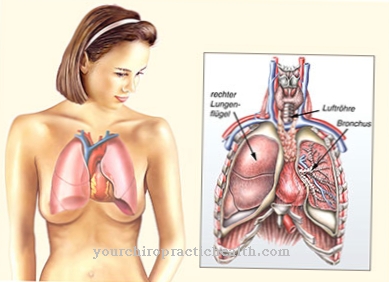As Lumbago or Sciatica syndrome is a suddenly occurring and usually sharp pain in the lower part of the back, i.e. the lumbar spine. From the doctors this will be lumbago called.
What is lumbago?

As Lumbago refers to a pain in the lower back that usually occurs without warning. Affected patients can hardly move or stretch and adopt a kind of relieving posture. Often the patients can only move in a curved manner. The result is usually that the entire back muscles cramp, which leads to further pain.
Since the pain from lumbago is very severe, most people suspect a herniated disc. However, this can only be diagnosed in very few cases - as a precaution, however, you should definitely consult a doctor if you have severe back pain.
It is not uncommon for people who suffer from lumbago to have back pain on a regular basis. A herniated disc can be distinguished from lumbago by the fact that the pain often radiates into the legs - lumbago usually only affects the lower back.
causes
The trigger for the Lumbago is usually just a small, careless movement, e.g. by incorrectly turning, lifting or bending over. Lumbago is also often caused by incorrectly straightening up during sports.
Through these wrong movements muscles are pulled or vertebrae blocked - the result is quite severe pain. In the area of the joints there are innumerable nerves and nerve fibers - these are the main trigger for the very strong pain.
Narrowing of the spine due to tumors is the cause of lumbago only in very rare cases.
Symptoms, ailments & signs
Lumbago usually occurs suddenly and almost immediately causes severe, stabbing back pain. The pain occurs in the lower back or in the area of the lumbar spine and becomes stronger or weaker depending on the body position. In the course of the disease, the lumbar spine may become rigid due to pain.
Those affected then move into a relieving posture with a straight lumbar spine or a bent back. When pressure is applied to the spinous processes of the lumbar vertebrae, severe pain occurs, which only slowly subsides. People who suffer from lumbago can usually no longer move and stretch. Even the smallest movements cause severe pain.
As a result, the back muscles cramp and the affected person instinctively bends forward. This gentle posture leads to an increase in pain and thus increases the lumbago. In some cases, severe pain can also cause gastrointestinal complaints. Nausea and vomiting are typical, occasionally accompanied by stomach cramps.
Lumbago usually persists for a few days and then subsides on its own, provided the patient is careful enough. If the causes are not treated, lumbago can occur again and again.
Course of disease
The good news for all patients with one Lumbago: With the right therapy, this usually disappears by itself after a few days. If the pain does not go away on its own within three days, however, you should consult a doctor; he will prescribe the appropriate medication or give injections. Patients who regularly suffer from lumbago should, however, consult a doctor, as this may be a harbinger of a herniated disc.
Complications
Complications are very rare with lumbago. However, it is entirely possible that the sciatica syndrome harbors unpleasant surprises or that it becomes chronic. The most common complications of lumbago are relapses.
The symptoms can reappear after a painless break of several months. If there are about six months between the lower back pain, it is usually another lumbago. Sometimes this is caused by a serious cause. This can be osteoporosis (bone loss) or a spondylolisthesis (vertebral sliding).
In some cases, the back pain does not go away completely. Instead, their intensity increases at repeated intervals. If this condition lasts longer than twelve weeks, the lower back pain has become chronic. In this case, the pain has developed into an independent disease. However, it is important to rule out other possible causes such as Bechterew's disease.
In some patients, complications set in at an early stage of lumbago. So the pain continues unabated or radiates into the leg or foot. Some people also suffer from sensitivity disorders such as numbness or tingling, weakened muscles or paralysis of the foot. The reason for these complications is usually a herniated disc. Slipping vertebrae, vertebral fractures, neuropathies of the spinal cord nerves and pathological changes in the spinal canal can also be responsible for the symptoms.
When should you go to the doctor?
Lumbago usually occurs suddenly and unexpectedly. When turning or lifting objects, a sharp pain sets in, which leads to a collapse. The affected person suffers immensely from the severe pain and an inability to move. A doctor should be consulted immediately, as the affected person no longer has any movement control over his body due to the spontaneous paralysis. Even the smallest attempts at movement lead to considerable pain. Moving is only possible with effort and the support of another person. The symptoms of paralysis often put those affected in fear and panic. A doctor can quickly relieve the symptoms.
In particularly severe cases, an emergency doctor must be called and the instructions of the rescue personnel must be followed until he arrives. The patient should not take any medication without consulting a healthcare professional. Side effects can occur that must be clarified in advance. The person affected should generally remain calm and breathe evenly in the event of lumbago. In many cases this enables very slow locomotion. At least the patient can bring his body under these conditions into a position that he perceives as more comfortable and relieving. Avoid further tremors on the way to a doctor.
Doctors & therapists in your area
Treatment & Therapy
To the Lumbago For targeted and effective treatment, the doctor must first know exactly when this occurred. Most patients can also describe this quite clearly. It is also important for the doctor whether the pain radiates into the legs, whether there are sensory disturbances or symptoms of paralysis or even problems with urination.
Now the patient's ability to move and reflexes are examined. X-ray, ultrasound and blood tests, as well as computed tomography, are often used to diagnose lumbago precisely.
Treatment generally depends on the underlying cause. In the case of a blocked vertebral body, for example, the only thing that usually helps is straightening - this should only be used by an experienced orthopedic surgeon. Normally, however, pain reliever medication is sufficient for lumbago; Warmth is also very good for your back. Absolute bed rest is hardly necessary with lumbago, you should only take it easy in the first few days. After that, however, exercise is an absolute must in order to get the muscles of the back going again. Diclofenac is one of the most commonly prescribed pain relievers for lumbago, it is given in the form of tablets.
Often, however, the doctor will also inject an anti-inflammatory drug directly into the back muscles. Physiotherapy, massages and back exercises can be used to support lumbago. If, on the other hand, a herniated disc is the trigger for the lumbago, often only an operation will help.
You can find your medication here
➔ Medicines for back painOutlook & forecast
Lumbago will go away on its own after a few days. If the condition is treated early, it will subside almost painlessly within one to three days, although slight back pain may persist for some time afterwards. In addition, there is a risk that a poor posture will set in as a result of lumbago. Especially with chronic complaints, there is a risk of unnatural postures of the back or head, which can lead to premature joint wear, tension and other health problems.
These risks can be avoided by using physiotherapy to treat the actual back condition. Patients with chronic back problems sometimes suffer from several lumbago in a row.Recurring complaints are an enormous burden for those affected, who often also suffer from chronic pain. A recurring sciatica syndrome indicates a herniated disc, which is associated with severe physical limitations for those affected.
Basically, however, the prognosis for lumbago is positive. If the condition is clarified and treated quickly, and the patient eliminates possible triggers, the risk of further complaints is relatively low. Lumbago does not reduce life expectancy.
prevention
Back pain in general and one in particular Lumbago To prevent this, it is very important to strengthen the back muscles. The right mattress also works wonders - it should be adapted to the body weight. It is particularly important to find a balance between sports activities in jobs that are mainly sedentary. Sports that are particularly easy on the back are swimming and cycling.
Aftercare
Immediately after the lumbago, the person affected should take it easy. It is important to give the back and especially the intervertebral discs sufficient time to recover. Any pain and cramps can be treated with the help of home remedies such as analgesic teas, massages, or hot baths. In the case of severe complaints, drugs from the pharmacy help. Acute pain is relieved with special back bandages.
In addition, the person concerned may have to use crutches to relieve the back during the recovery phase. Follow-up care always includes regular follow-up checks by the chiropractor or orthopedic surgeon. The condition should subside within a few days to weeks. Then the cause must be determined so that lumbago does not recur.
If there is a vertebral joint blockage, a physiotherapist must be consulted. The specialist can manually straighten the joint again and thereby relieve the pain. Acupuncture and alternative measures can also be part of the aftercare if it is a chronic condition. Follow-up examinations should be performed at least every two weeks.
If the course is positive, the intervals can be extended. The chronically ill must stay in constant contact with an orthopedic surgeon. Part of the aftercare also includes preventing further lumbago. This is achieved through the use of a special bed, back-friendly shoes and comparable measures.
You can do that yourself
A doctor does not always have to be called in with lumbago. Often the symptoms can be reduced by simple measures and home remedies.
In the case of acute lumbago, the load should be stopped immediately. However, long periods of sitting or lying down are not recommended as this can lead to further hardening of the muscles. Gentle exercise and regular relaxation are better. If you still have to sit, use a stool or exercise ball. Light stretching exercises are also helpful. An effective workout: gently lay down on the floor with your arms and legs extended. This relieves the nerves and loosens the muscles.
Heat treatments, hot showers or massages help against the pain. A so-called Schlenzbad, in which the temperature is gradually increased, has also proven itself. Essential oils are recommended as a support. Pine, spruce, mint or lavender, for example, can be used in the form of massages and rubs and promise a rapid improvement in symptoms. Teas, for example with birch leaves, elderberry or linden blossoms, also have a pain-relieving effect. If the symptoms do not go away as a result of the measures mentioned, a visit to the doctor is recommended.

.jpg)

.jpg)
.jpg)








.jpg)

.jpg)
.jpg)











.jpg)